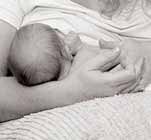Healing After Delivery

Postpartum watershed
 The weight loss alone is breathtaking. Subtracting the combined weight of a baby, a placenta, blood and amniotic fluid leaves most women 6kg lighter and physicallx disoriented. The body works hard to retain water during pregnancy, and after delivery all that extra fluid is lost in the form of sweat and urine. New mothers perspire a lot, and often produce an astounding amount of urine a day.
The weight loss alone is breathtaking. Subtracting the combined weight of a baby, a placenta, blood and amniotic fluid leaves most women 6kg lighter and physicallx disoriented. The body works hard to retain water during pregnancy, and after delivery all that extra fluid is lost in the form of sweat and urine. New mothers perspire a lot, and often produce an astounding amount of urine a day.
The shrinking uterus
Uterine contractions continue after birth. At the time of delivery, the uterus is 25 times its pre-pregnancy size. Within minutes it begins to shrink, and the process causes afterpains. The uterus halves its pregnancy size within a week and is back to normal pre-pregnancy size within 4 weeks. The innermost layer of uterine cells (called the endometrial deciduae), begins to slough off and is passed as a menstrual-like discharge called lochia that lasts for weeks. Initially bright red, it becomes lighter in colour, fading to white or yellow before it stops.
Hormonal changes
The fall in pregnancy hormones after delivery of your baby, can leave tissues soft and boggy, resulting in swollen feet and natural shedding of hair. Vaginal laxity and some leaking of urine are not unusual.
 Pregnancy hormones transform your breasts. After delivery, milk production is stimulated by your baby’s suckling and the hormones prolactin and oxytocin
Pregnancy hormones transform your breasts. After delivery, milk production is stimulated by your baby’s suckling and the hormones prolactin and oxytocin
Postpartum hormonal swings can cause emotional and mood swings in the few months after delivery. It’s normal to feel overwhelmed and weepy-symptoms commonly known as the baby blues. Beware of postpartum depression, talk to us or see your doctor if feelings of doubt, despair, and malaise don’t go away after two weeks.
If reading this makes you feel tired, it’s no wonder. This dramatic transformation from pregnant woman to new mother is exhausting and miraculous. In a matter of weeks your body reverses physical changes that took nine months to develop. Don’t worry — you’ll get through it, especially with the help of that most glorious distraction: a living, breathing baby.
Postpartum haemorrhoids
Haemorrhoids (Piles) are varicose veins — swollen blood vessels — in the rectal area. Haemorrhoids can range from the size of a raisin to the size of a grape. They can be itchy or painful, and sometimes can cause rectal bleeding, especially during a bowel movement. Sometimes the enlarged veins protrude through the anus.
Haemorrhoids are relatively common during pregnancy and the postpartum period. Some women get them for the first time while pregnant — if you had them before pregnancy, you’re likely to get them again while pregnant. Luckily, they often go away on their own or soon after delivery.
Why haemorrhoids:
- The growing uterus puts pressure on the pelvic and abdominal veins. This can slow the return of blood from the lower half of your body, increasing the pressure on the veins below your uterus and causing them to become more dilated or swollen
- Constipation can also cause or aggravate haemorrhoids
- Progesterone increase during pregnancy causes the walls of your veins to relax, allowing them to swell more easily. Progesterone also contributes to constipation by slowing down your intestinal tract
- Haemorrhoids are also a result of pushing during the second stage of labour
Measures for relief:
- Ice packs to the affected area several times a day help decrease swelling and discomfort. Some women find cold compresses saturated with witch hazel to be soothing.
- Soak your bottom in warm water, in a tub or a sitz bath.
- Alternating cold and warm treatments.
- Topical anaesthetic or medicated suppository. Talk to us about haemorrhoid-relief medications
- Take the pressure off your rectal veins to relieve the pain. Avoid sitting or standing for long stretches of time.
Avoidance and prevention:
- Avoid constipation: Eat a high-fibre diet, drink plenty of water (eight to ten glasses a day), and get regular exercise
- Avoid straining when moving your bowels, and don’t linger on the toilet
- Do Kegel exercises daily. Kegels increase circulation in the rectal area and strengthen the muscles around the anus, decreasing the chance of haemorrhoids. They also strengthen and tone the muscles around the vagina and urethra, helping your body recover after you give birth
Call us if your own relief efforts don’t help — or if you notice bleeding — In most cases, haemorrhoids that develop during pregnancy will get better on their own, especially if you’re careful to avoid constipation. If some cases, you may need to see a specialist for treatment to help shrink your haemorrhoids. Rarely, minor surgery is required to correct the problem.

Our goal at Birthright is to provide you the best gynaecological care in a friendly and relaxed atmosphere, where you can talk to us about your needs.
Call us and discuss your care.
0800 247 848
